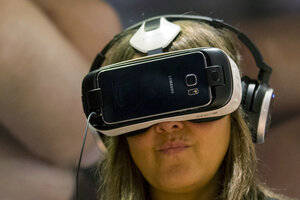Virtual reality gets more real
A technology that offers an altered state of human consciousness – and a slew of ethical questions – is finally hitting the marketplace.

An attendee uses a virtual reality device to watch a movie during the Clinton Global Initiative's annual meeting in New York in September 2015.
Brendan McDermid/Reuters/File
Oculus Rift sounds as if it’s a science fiction robot that morphs into a snazzy car. Instead it’s the best-known name emerging so far in a new area of technology that lies just this side of science fiction.
Virtual reality (VR) claims to be more than just another advance in entertainment or education or business communication. It plans to be a whole new version of “reality.”
By wearing bulky, wrap-around dark glasses (the user looks pretty nerdy), people can intensely experience two powerful human senses, sight and sound.
What will they see and hear? Video game players might undertake incredibly realistic adventures as the action surrounds them 360 degrees. Or students might “virtually” visit the Pyramids or an art museum half a world away. Sports fans could view a big game as though they’re sitting right on the sidelines. Business people in distant cities could meet “in person” with a sense of realism and “presence” that would make today’s video conferencing seem dull and archaic.
And what if news viewers could be taken by VR to the site of a Syrian refugee camp and allowed to tour it on their own? Might that change how they feel about the refugees’ plight?
Oculus Rift, which Facebook bought for $2 billion in 2014, has just announced at the Consumer Electronics Show in Las Vegas that its VR product will be available later this spring for $599. That’s if you already own a very powerful computer that can run it. Otherwise, figure on spending another $1,200 or so.
That price would seem to scare off all but the earliest adopters. But cheaper versions of VR (though not as powerful) already exist, and prices for electronics traditionally fall quickly.
Skeptics still wonder about all the fuss. Less than three years ago Google Glass promised to be a revolutionary new “wearable” technology, and now Google apparently has quietly hid the glasses away in a dusty closet somewhere hoping they’ll be forgotten.
But filmmaker Chris Milk, who is already producing VR documentaries, says that sooner or later VR is going to produce some profound ethical debates. What will be the responsibilities of those creating these ultra-real VR experiences? And what will be the effects on those who use VR?
“In terms of an altered state of human consciousness being on the horizon, right now we’re still in the darkness of night, poking around with flashlights and trying to find our way there,” he told The Guardian. “What you’re talking about at some point is more than a medium, but is fundamentally an alternative level of human consciousness.”
Today’s VR is still taking baby steps. Using the equipment can cause unpleasant physical side effects, much as early 3-D glasses did. And it’s still a sit-down activity (though spinning around on a swivel chair apparently is a great way to take advantage of the 360-degree view). Getting up and physically wandering around in a virtual environment (a la the Holodeck on “Star Trek” ) is a far more complicated technological problem.
But already the intensity of the experience is a game changer. “Scares in VR are borderline immoral,” says Alex Schwartz, who heads VR maker Owlchemy Labs, in a Wall Street Journal story. “We have to be very careful.”
Others don’t see what’s so new since people already can get deeply immersed in a movie or video game, or in an even earlier technology – a book. But Stanford University professor Jeremy Bailenson, who has studied VR for 15 years, says we underestimate VR at our peril.
“The question isn’t: Is VR good or bad? You’d never ask that about the written word or video,” he told the Journal. “But I’m hoping that people are careful. We don’t know what’s going to happen.”
We need not fear VR any more than any other new technology. But understanding it will make sure people use it to their benefit and not their harm.

